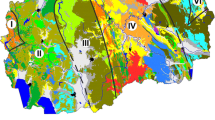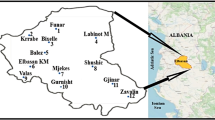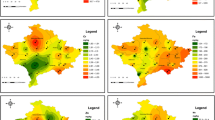Abstract
Background, aim, and scope
The moss technique is widely used to monitor atmospheric deposition of heavy metals in many countries in Europe, whereas this technique is scarcely used in Asia. To implement this international reliable and cheap methodology in the Asian countries, it is necessary to find proper moss types typical for the Asian environment and suitable for the biomonitoring purposes. Such a case study was undertaken in Vietnam for assessing the environmental situation in strongly contaminated areas using local species of moss Barbula indica.
Materials and methods
The study is focused on two areas characterized by different pollution sources: the Hanoi urban area and the Thainguyen metallurgical zone. Fifty-four moss samples were collected there according to standard sampling procedure adopted in Europe. Two complementary analytical techniques, atomic absorption spectrometry (AAS) and instrumental neutron activation analysis (INAA), were used for determination of elemental concentrations in moss samples. To characterize the pollution sources, multivariate statistical analysis was applied.
Results and discussion
A total of 38 metal elements were determined in the moss by the two analytical techniques. The results of descriptive statistics of metal concentration in moss from the city center and periphery of Hanoi determined by AAS are presented. The similar results for moss from Thainguyen province determined by INAA and AAS are given also. A comparison of mean elemental concentrations in moss of this work with those in different environmental conditions of other authors provides reasonable information on heavy metal atmospheric deposition levels. Factor loadings and factor scores were used to identify and apportion contamination sources at the sampling sites. The values of percentage of total of factors show two highly different types of pollution in the two examined areas—the Hanoi pollution composition with high portion of urban-traffic activity and soil dust (62%), and the one of Thainguyen with factors related to industrial activities (75%). Besides, the scatter of factors in factor planes represents the greater diversity of activities in Hanoi than in Thainguyen.
Conclusions
Good relationship between the result of factor analysis and the pollution sources evidences that the moss technique is a potential method to assess the air quality in Vietnam.
Recommendations and perspectives
Moss B. indica widely distributed in Vietnam and Indo-China is shown to be a reliable bryophyte for biomonitoring purposes in sub-tropic and tropic climate. However, the necessity of moss interspecies calibration is obvious for further studies in the area to provide results compatible with those for other Asian countries and Europe.



Similar content being viewed by others
References
ADB (2002) Integrated action plan to reduce vehicle emissions in Vietnam in Asian Development Bank. http://www.adb.org/documents/others/Reduce_Vehicle_Emissions_VIE/Reduce_Vehicle_Emissions.pdf
Buschmann J, Berg M, Stengel C et al (2008) Contamination of drinking water resources in the Mekong delta floodplains. Environ Int 34(6):756–764
Daly D, Costa D, Melo A (2006) The ‘sala o’ vegetation of Southwestern Amazona. Biodivers Conserv 15:2905–2923. doi:10.1007/s10531-005-3429-x
Eddy A (1990) A handbook of Malesian Mosses, Leucobryaceae to Buxbaumiaceae. Natural History Museum Publications, London
Frontasyeva MV, Pavlov SS (2000) Analytical investigations at the IBR-2 reactor in Dubna. JINR preprint E14-2000-177, Dubna
Frontasyeva MV, Steinnes E, Lyapunov SM et al (2000) Biomonitoring of heavy metal deposition in the South Ural region. J Radioanal Nucl Chem 245(2):415–420 (1999) JINR Prepint, E14-99-257, Dubna
Gombert S, Rausch de Traubenberg C, Galsomies L et al (2002) Atmospheric metal deposition based on moss analysis. Pollut Atmos 173:99–121
Grodzinska K, Frontasyeva MV (2003) Trace element contamination in industrial regions of Poland studied by moss monitoring. Environ Monit Assess 87(3):255–270
Lee CSL, Li XG, Zhang X et al (2005) Biomonitoring of trace metals in the atmosphere using moss in the Nanling Mountains and the Pearl River Delta, Southern China. Atmos Environ 39:397–407
Marcussen H, Dalsgaard A, Holm PE (2008) Content, distribution and fate of 33 elements in sediments of rivers receiving wastewater in Hanoi, Vietnam. Environ Pollut 155(1):41–51
Mulgrew A, Williams P (2000) Biomonitoring using plants, Air hygiene report N10. http://www.umweltbundesamt.de/whocc/AHR10/II-HM-1.htm
Nguyen HK (1996) Building up of the air quality monitoring network based on the air pollution prediction up to 2010. Hanoi University of Construction, Hanoi 142
Pham BQ, Dang DN, Nguyen VS (1995) Environmental pollution in Vietnam: analytical estimation and environmental priorities. Trends Anal Chem 14:383–388
Pham DH et al (1999) Temporal variations of source impacts at the receptor, as derived from air particulate monitoring data in Ho Chi Minh City, Vietnam. Atmos Environ 33(19):3133–3142
Pham DH et al (2004) PMF receptor modelling of fine and coarse PM10 in air masses governing monsoon conditions in Hanoi, northern Vietnam. Atmos Environ 38(2):189–201
Polya DA, Berg M, Gault AG et al (2008) Arsenic in groundwaters of South-East Asia: with emphasis on Cambodia and Vietnam. doi:10.1016/j.apgeochem.2008.06.024
Reynolds B, Mills G, Pugh B (2001) Monitoring of atmospheric heavy metal deposition in Europe using bryophytes. Experimental protocol 2000/2001survey UNECE, International cooperative programme on effect of air pollution on natural vegetation and crops, Centre for Ecology and Hydrology, Bangor
Ruhling A (2002) A European survey of atmospheric heavy metal deposition in 2000–2001. Environ Pollut 120(1):23–25
Rummel RJ (1970). Understanding factor analysis. http://www.hawaii.edu/powerkills/UFA.HTM#35#35
Steinnes E (1993) Some aspects of biomonitoring of air pollutants using mosses as illustrated by the 1976 Norwegian survey. In: Markert B (ed) Plants as biomonitors: indicators for heavy metals in the terrestrial environment. VCH Publishers, Weinheim, pp 381–394
Steinnes E, Berg T, Sjobakk TE et al (2000) Atmospheric deposition of heavy metals in Norway. Nation-wide survey, Report 838/2001. State Pollution Control Authority, Oslo
Tarafdar SA et al (1997) Biomonitoring of chemical pollutants in the terrestrial environment using nuclear-related analytical techniques. Seminar on Monitoring of Air Quality and Acid Rain in Bangladesh, Atomic Energy Centre, Dhaka, 12 April
Tarras-Wahlberg H, Tarras-Wahlberg N, Nguyen LT (2008) Environmental regulatory failure and metal contamination at the Giap Lai pyrite mine, Northern Vietnam. J Environ Manag 86(4):712–720
Tran N (2001) Bryophyte of Vietnam—checklist of plant species of Vietnam, Vol. 1. Center for Natural Resources and Environmental Studies, National University of Hanoi, Agriculture Publishing House, Hanoi, pp 863–950, (in Vietnamese)
VNJMS (2002) Summary of meteorological, agro-meteorological, hydrological and marinological states (in Vietnamese). Vietnamese Journal of Meteorological Science 5, 6, 7/2002: 52–57, 51–58, 53–57
Xiao Z, Sommar J, Lindqvist O (1997) Atmospheric mercury deposition on Fanjing mountain nature reserve, Guizhou, China. Chemosphere 36:2191–2200
Acknowledgments
The authors thank Springer Science and Business Media for granting a permission to reuse figures in Nguyen-Viet et al. in Microbial Ecology 53(1):53–65. This study was supported by the University of Franche-Comté, the Hanoi University of Education, the French Embassy in Vietnam, and the Swiss National Science Foundation (SNSF) and the Swiss Agency for Development and Cooperation (SCD) through the program of the National Center for Competences in Research (NCCR) North–South.
Author information
Authors and Affiliations
Corresponding author
Additional information
Responsible editor: Henner Hollert
Rights and permissions
About this article
Cite this article
Nguyen Viet, H., Frontasyeva, M.V., Trinh Thi, T.M. et al. Atmospheric heavy metal deposition in Northern Vietnam: Hanoi and Thainguyen case study using the moss biomonitoring technique, INAA and AAS. Environ Sci Pollut Res 17, 1045–1052 (2010). https://doi.org/10.1007/s11356-009-0258-6
Received:
Accepted:
Published:
Issue Date:
DOI: https://doi.org/10.1007/s11356-009-0258-6




